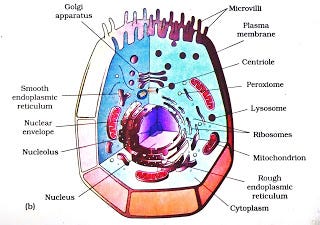What is cell | Cell structure and function | Cell types | Structure of plant cell wall
HomeWhat is cell What is cell | Cell structure and function | Cell types | Structure of plant cell wall
“ Cell, in biology, the basic membrane-bound unit that contains the fundamental molecules of life and of which all living things are composed.”
A single cell is often a complete organism in itself, such as a bacterium or yeast. Other cells acquire specialized functions as they mature. These cells cooperate with other specialized cells and become the building blocks of large multicellular organisms, such as humans and other animals. Although cells are much larger than atoms, they are still very small. The smallest known cells are a group of tiny bacteria called mycoplasmas; some of these single-celled organisms are spheres as small as 0.2 μm in diameter (1μm = about 0.000039 inch), with a total mass of 10−14 gram-equal to that of 8,000,000,000 hydrogen atoms. Cells of humans typically have a mass 400,000 times larger than the mass of a single mycoplasma bacterium, but even human cells are only about 20 μm across. It would require a sheet of about 10,000 human cells to cover the head of a pin, and each human organism is composed of more than 30,000,000,000,000 cells.

Cells contain a special collection of molecules that are enclosed by a membrane. These molecules give cells the ability to grow and reproduce. The overall process of cellular reproduction occurs in two steps: cell growth and cell division. During cell growth, the cell ingests certain molecules from its surroundings by selectively carrying them through its cell membrane. Once inside the cell, these molecules are subjected to the action of highly specialized, large, elaborately folded molecules called enzymes. Enzymes act as catalysts by binding to ingested molecules and regulating the rate at which they are chemically altered. These chemical alterations make the molecules more useful to the cell. Unlike the ingested molecules, catalysts are not chemically altered themselves during the reaction, allowing one catalyst to regulate a specific chemical reaction in many molecules.
Biological catalysts create chains of reactions. In other words, a molecule chemically transformed by one catalyst serves as the starting material, or substrate, of a second catalyst and so on. In this way, catalysts use the small molecules brought into the cell from the outside environment to create increasingly complex reaction products. These products are used for cell growth and the replication of genetic material. Once the genetic material has been copied and there are sufficient molecules to support cell division, the cell divides to create two daughter cells. Through many such cycles of cell growth and division, each parent cell can give rise to millions of daughter cells, in the process converting large amounts of inanimate matter into biologically active molecules .
Structure of plant cell wall
Originally published at https://www.thebioquick.com.
